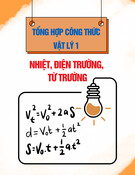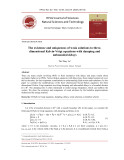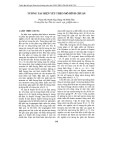
VNU Journal of Science: Mathematics – Physics, Vol. 41, No. 1 (2025) 17-25
17
Original Article
Topological Solitons in High-order Nonlinear Material
with Moiré Photonic Lattices
Nguyen Thanh Luan1, Ngo Trong Dat1, Nguyen Luong Thien2,
Duong Chinh Cuong3, Nguyen Duc Anh Quan4, Do Duc Tho4, Nguyen Viet Hung5,*
1Hanoi University of Science and Technology, 1 Dai Co Viet, Hanoi, Vietnam
2Space Technology Institute, 18 Hoang Quoc Viet, Hanoi, Vietnam
3Phenikaa University, To Huu, Hanoi, Vietnam
4Faculty of Engineering Physics, Hanoi University of Science and Technology,
1 Dai Co Viet, Hanoi, Vietnam
5Faculty of Electronic Materials and Devices, Hanoi University of Science and Technology,
1 Dai Co Viet, Hanoi, Vietnam
Received 3rd September 2024
Revised 29th November 2024; Accepted 17th February 2025
Abstract: Moiré photonic lattices provide tunable geometric configurations that enable the
formation and control of topological solitons. These solitons depend on the interplay between the
underlying lattice geometry and high-order nonlinearities such as third and fifth-order effects. In this
work, we employ Moiré lattices generated in a high-order nonlinear material to investigate the
existence of topological solitons under diverse geometries, which are controlled by the twisting
angle of sublattices. The formation of solitons in both commensurate and incommensurate Moiré
lattice configurations allows us to explore deeper into the impact of geometric transitions on soliton
stability and localization. The findings have potential applications in advanced photonic systems,
including topological photonics and all-optical switching, where soliton stability and control are
significant factors that can be optimized to enhance performance and functionality.
Keywords: Topological solitons, Moiré photonic lattices, high-order nonlinear materials, photonic
waveguides. *
________
* Corresponding author.
E-mail address: hung.nguyenviet1@hust.edu.vn
https//doi.org/10.25073/2588-1124/vnumap.4965

N. T. Luan et al. / VNU Journal of Science: Mathematics – Physics, Vol. 41, No. 1 (2025) 17-25
18
1. Introduction
Moiré photonic lattices have attracted significantly extensive interests in recent years, particularly
in the context of the search for topological solitons in high-order nonlinear materials. This is due to the
unique structural dynamics and enhanced stability of such lattices. Moiré patterns are created by
superimposing two periodic structures with a slight rotational misalignment [1]. The concept of Moiré
patterns has been known and utilized in various fields such as art, textile industry, architecture, and
twistronics for many years [2-4]. In 2018, researchers discovered that stacking two layers of graphene
with a “magical” offset angle of 1.1 degrees could induce superconductivity [5]. Additionally, these
patterns have been used to manipulate cold atoms based on graphene-based systems [6, 7]. The potential
of Moiré lattices to investigate a wide range of unique physical phenomena has recently prompted a
surge of interest in the fields of optics, photonics, and condensed matter physics. They are among the
tools utilized for the control and manipulation of light propagation, including delocalization-localization
of light, magic-angle lasers, and topological defects [8-10] and can be enabled to enhance spatial
dispersion and manipulate light on metasurface optics [11, 12]. The mutual rotation of two identical
sublattices allows the generation of commensurable and incommensurable Moiré patterns with tunable
amplitudes and twist angles. This tunability is crucial for studying the localization and delocalization of
light, as well as for investigating the physics of flat-band structure [13].
In the fields of mathematics and physics, a soliton is defined as a nonlinear, self-reinforcing,
localized wave packet that maintains its shape while propagating at a constant velocity [14]. This
stability is noteworthy, as solitons are capable of re-establishing their form even after colliding with
other solitons [15]. Solitons provide stable solutions to a wide class of weakly nonlinear dispersive
partial differential equations, which describe various physical systems. A topological soliton, also
known as a topological defect, is a solution to a set of partial differential equations that is stable against
decay to the trivial solution. Vortex solitons are a specific type of topological soliton characterized by a
phase singularity, which means they have a point where the phase of the wave function is undefined.
This results in a "vortex" structure, where the wave function circulates around the singularity. Vortex
solitons have been studied for their potential applications in various fields such as optical tweezers that
trap particles [16], enlarging the capacity of optical communication [17] and high-order quantum
entanglement [18]. Their unique properties and stability make them valuable for understanding complex
physical phenomena and developing advanced technological applications. In nonlinear optics,
fundamental solitons in the media with saturable [19] and vortex solitons with cubic (Kerr) [20] on
Moiré lattices have been studied. The nonlinear cubic SchrÖdinger equation with external lattices
corresponds to numerous optical materials such as potassium niobate (KNbO3) [21] or lithium niobate
(LiNbO3) [22]. For carbon disulfide (CS2) material, which elucidates high-order nonlinearities where
the competition between cubic and quintic nonlinearities leads to unique soliton dynamics [23].
Both third-order and fifth-order nonlinear optical media can support solitons, but the third-order
Kerr term will exhibit catastrophic self-focusing if the beam intensity exceeds a threshold [24]. In the
presence of fifth-order nonlinearity, the system becomes more stable because the self-defocusing effects
of the fifth-order term counteract the self-focusing. The solitons in these competing cubic-quintic
nonlinear systems are more robust and resilient to external perturbations, contributing to their increased
stability.
In this work, we investigated the formation and stability of topological solitons in a high-order
nonlinear material within Moiré photonic lattices. By using square operator method (SOM), we explored
the different configurations that were controlled by the twisting angles of sublattices and how they
influence the existence of solitons and behavior of soliton characteristics. This method allowed us to
examine the impact of both commensurate and incommensurate Moiré lattice structures on soliton

N. T. Luan et al. / VNU Journal of Science: Mathematics – Physics, Vol. 41, No. 1 (2025) 17-25
19
formation. We then systematically analyzed the stability of these solitons by doing direct numerical
simulation using split-step Fourier method.
2. Model and Method
In the paraxial approximation [24], the propagation of laser beams in a nonlinear optical medium is
governed by the nonlinear Schrodinger equation (NLSE), written for the complex envelope A(x,y,z) of
the electric field as the following:
2𝑖𝑘𝜕𝐴
𝜕𝑧 +𝜕2𝐴
𝜕𝑥2+𝜕2𝐴
𝜕𝑦2+2𝑘2(𝛿𝑛 +𝑛NL(|𝐴|2))𝐴 = 0, (1)
where 𝑘 = 𝜔/𝑐 is wavevector, 𝛿𝑛 is the variation of linear refractive index and 𝑛NL(|𝐴|2) is a
contribution of nonlinear refractive index. The latter term is a function of the beam’s intensity. To
account for the higher-order nonlinear material, we will consider carbon disulfide as a specific case in
this work as its nonlinear optical properties were reported in [23]. The total refractive index of CS2 can
be expressed as 𝑛 = { 1+ 𝑅𝑒[𝜒(1) +3𝜒(3)|𝐴|2+10 𝜒(5)|𝐴|4]}1/2, with 𝑅𝑒[𝜒(3)]≈ 2.8×
10−21(𝑚2/𝑉2), 𝑅𝑒[𝜒(5)]≈ −1.2×10−39(𝑚4/𝑉4) at wavelength 920 nm. By substituting this into
(1), we obtain following equation:
2𝑖𝑘𝜕𝐴
𝜕𝑧 +𝜕2𝐴
𝜕𝑥2+𝜕2𝐴
𝜕𝑦2+𝜔2
𝑐2[𝛿𝑛 𝐴 + 3𝜒(3)𝐴|𝐴|2+10𝜒(5)𝐴|𝐴|4]= 0. (2)
After normalizing, the equation (2) turns into:
𝑖𝜕𝜓
𝜕𝑍 +1
2(𝜕2𝜓
𝜕𝑋2+𝜕2𝜓
𝜕𝑌2)+𝐼(𝑟)ψ+|𝜓|2ψ− (𝛽 −𝑖𝛾)|𝜓|4ψ = 0.
(3)
Here 𝑋 = 𝑥/𝑤0,𝑌 = 𝑦/𝑤0, and 𝑍 = 𝑧/𝑙, with 𝑤0 being the initial beam waist and 𝑙 = 𝑛0𝜔𝑤0
2/𝑐 a
characteristic length. The rescaling intensity is 𝐼𝑟= 2𝑐2/3𝜔2𝑤2𝜒(3) and the normalized field equals to
𝜓 = 𝐴/√𝐼𝑟. The coefficients 𝛽 and 𝛾 nonlinearities can be derived from the optical properties of CS2,
satisfying the relation (𝛽 −𝑖𝛾) = −20
9𝑐2
𝜔2𝑤0
2𝜒(5)
[𝜒(3)]2. After doing the calculations, we get the values 𝛽 =
0.028 and 𝛾 = 0. Therefore, this conservative case will ensure the existence of stable solitons. We then
apply equation (3) with Moiré photonic lattices and the final model to search for soliton solutions is
presented as:
𝑖𝜕𝜓
𝜕𝑍 +1
2𝛻⊥
2𝜓+𝐼(𝑟)ψ+|𝜓|2𝜓−0.028|𝜓|4𝜓 = 0,
(4)
where ψ is the dimensionless light field amplitude, 𝑍 is the propagation distance, 𝑟 = (𝑋,𝑌) are the
transverse coordinates, ∇= (∂𝑋,∂𝑌) is the gradient operator and 𝐼(𝑟)= |𝐼1𝑉(𝑅(θ)𝑟)+𝐼2𝑉(𝑟)|2 is the
function describing the Moiré lattices created by the superposition of two square sublattices with 𝐼1,𝐼2
are the amplitudes of both square sublattices, 𝑉(𝑟) is the potential of the sublattices [6]. In Fig. 1 there
are shown some configurations of Moiré lattices according to commensurate and incommensurate cases.
In order to obtain the soliton solutions of Eq. (4), we use SOM. Finding soliton solutions for complex
function U(r) and propagation constant 𝜇 in formula 𝜓(𝑟,𝑧)= 𝑈(𝑟)𝑒𝑖μ𝑧.
−𝜇𝑈+1
2(𝑈𝑥𝑥 +𝑈𝑦𝑦)+𝐼(𝑥,𝑦)𝑈 +|𝑈|2𝑈−0.028|𝑈|4𝑈 = 0 (5)
Starting with the operator ℒ0:
ℒ0𝑈 = −𝜇𝑈 +1
2𝛥𝑈+𝐼(𝑋,𝑌)𝑈 +𝛾|𝑈|2𝑈−𝛽|𝑈|4𝑈 (6)

N. T. Luan et al. / VNU Journal of Science: Mathematics – Physics, Vol. 41, No. 1 (2025) 17-25
20
Here, 𝜇 represents the eigenvalue or propagation constant. By decomposing ℒ0 into its real and
imaginary components and applying the Fourier transform, we derive the sub-operators 𝑇1 and 𝑇2:
𝑇1=Re (ℱ−1 (ℱ(ℒ0𝑈)
𝐾2+𝑐 )), 𝑇2=Im (ℱ−1 (ℱ(ℒ0𝑈)
𝐾2+𝑐 )) (7)
By decomposing the complex amplitude ψ into its real and imaginary parts, ψ = 𝑈𝑟𝑒(𝑥,𝑦)+
𝑖𝑈𝑖𝑚(𝑥,𝑦), and substituting into the operator ℒ0𝑢, we get the sub-operators ℒℛℯ and ℒℐ𝓂:
ℒℛℯ = −𝜇𝑈𝑟𝑒 +1
2𝛥𝑈𝑟𝑒 +𝐼(𝑥,𝑦)𝑈𝑟𝑒 +𝛽(𝑈𝑟𝑒
3+𝑈𝑟𝑒𝑈𝑖𝑚
2)−𝛾(𝑈𝑟𝑒
2+𝑈𝑖𝑚
2)2𝑈𝑟𝑒 (8)
ℒ𝒾𝓂 = −𝜇𝑈𝑖𝑚 +1
2𝛥𝑈𝑖𝑚 +𝐼(𝑥,𝑦)𝑈𝑖𝑚 +𝛽(𝑈𝑖𝑚
3+𝑈𝑖𝑚𝑈𝑟𝑒
2)−𝛾(𝑈𝑖𝑚
2+𝑈𝑟𝑒
2)2𝑈𝑖𝑚 (9)
a)
b)
c)
d)
Figure 1. Two square sublattices stacked on top of each other before twisting (a) and Moiré photonic lattices
with twisting angle 𝜃 = 𝑎𝑟𝑐𝑡𝑎𝑛(5/12), 𝜃 = 𝑎𝑟𝑐𝑡𝑎𝑛(3/4) (commensurate) (b),
(c) and 𝜃 = 𝑝𝑖/6 (incommensurate) (d).
After taking the partial derivatives of ℒℛℯ and ℒℐ𝓂 with respect to both 𝑈𝑟𝑒 and 𝑈𝑖𝑚, we obtain the
elements of the operator ℒ1:
𝑅11 =𝜕ℒℛℯ
𝜕𝑈𝑟𝑒 (𝑇1), 𝑅12 =𝜕ℒℛℯ
𝜕𝑈𝑖𝑚 (𝑇2) (10)
𝑅21 =𝜕ℒℐ𝓂
𝜕𝑈𝑟𝑒 (𝑇1), 𝑅22 =𝜕ℒℐ𝓂
𝜕𝑈𝑖𝑚 (𝑇2) (11)
Thus, the operator ℒ1 is defined as:

N. T. Luan et al. / VNU Journal of Science: Mathematics – Physics, Vol. 41, No. 1 (2025) 17-25
21
ℒ1𝑈 = 𝑅11 +𝑅12 +𝑖(𝑅21 +𝑅22) (12)
Then we apply the SOM to find the steady-excited state solutions known as vortex solitons, which
were introduced by Yang [24]. This method has been shown to be effective for finding steady-state
solutions in a variety of nonlinear wave equations. With the vortex soliton solutions obtained, we can
test their stability by performing direct perturbation simulations in real time using the split-step Fourier
method.
3. Results and Discussion
In this section, we present the results of the search for topological solitons in high-order nonlinear
material with Moiré photonic lattices from commensurate to incommensurate geometries. We look for
these topological states in the form 𝜓(𝑟,𝑧)= 𝑈(𝑟)𝑒𝑖μ𝑧 with complex amplitude function U(r) and
corresponding propagation constant 𝜇. To characterize the properties of the vortex solitons, we based
on the dependence of power 𝑃 = ∬|𝑈|2 𝑑2𝑟 and form factor 𝜒 = (∬|𝑈|4 𝑑2𝑟)1
2 / 𝑃 on the
propagation constant 𝜇 [25].
3.1. The Different Properties of Fundamental Soliton and Vortex Solitons
Figure 2. Comparison in power and form factor versus propagation constant 𝜇 between fundamental (𝑃1,𝜒1) and
vortex solitons (𝑃2,𝜒2) versus propagation constant 𝜇 with 𝜃 = 𝑎𝑟𝑐𝑡𝑎𝑛(5/12) (a) and profiles of fundamental
soliton and phase at point 1 (b), (c) and vortex soliton at point 2 (d), (e).
In Fig. 2, the graph demonstrates the different properties of fundamental and vortex solitons
influenced by twist angle 𝜃 = 𝑎𝑟𝑐𝑡𝑎𝑛(5/12) with the equal depth of two sublattices 𝐼1= 𝐼2= 2. The
fundamental solitons, which were reported in [25], display lower power when compared to the vortex
soliton. As 𝜇 increases, the power rises steadily but it remains smaller in magnitude than that of the
vortex soliton. The form factor of the fundamental soliton starts relatively high, increasing with 𝜇 and
the rate of increase is larger than the vortex soliton due to its energy concentration on a single peak,
which represents a simpler spatial profile. The vortex soliton requires higher power than the fundamental
soliton to maintain the stability of each peak surrounded center. When 𝜇 increases, the vortex soliton’s
power rises more rapidly, which reflects the more complex structure of this type of soliton. To be more
specific, Figs. 2b and 2d show the distinct profiles of the fundamental, the vortex soliton and their




















![Bộ câu hỏi lý thuyết Vật lý đại cương 2 [chuẩn nhất/mới nhất]](https://cdn.tailieu.vn/images/document/thumbnail/2025/20251003/kimphuong1001/135x160/74511759476041.jpg)
![Bài giảng Vật lý đại cương Chương 4 Học viện Kỹ thuật mật mã [Chuẩn SEO]](https://cdn.tailieu.vn/images/document/thumbnail/2025/20250925/kimphuong1001/135x160/46461758790667.jpg)




